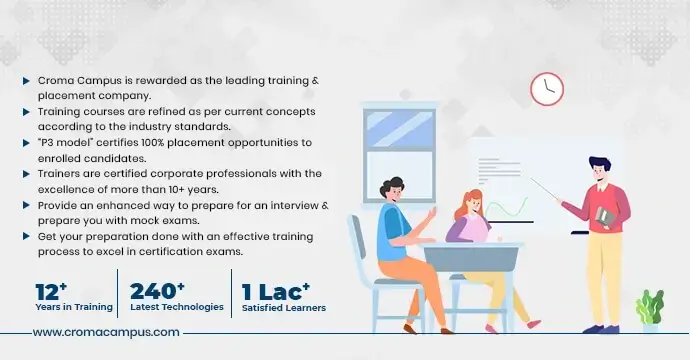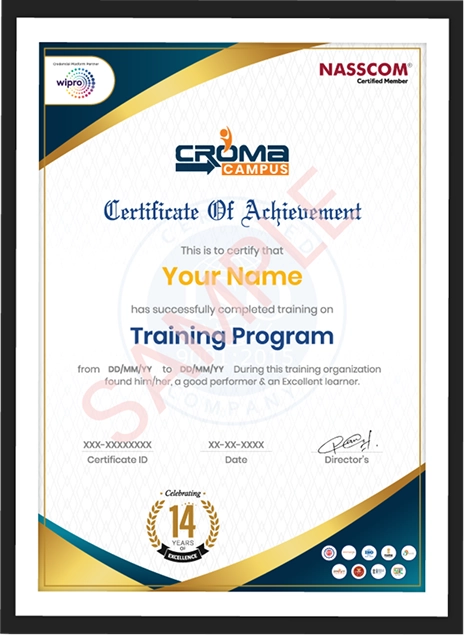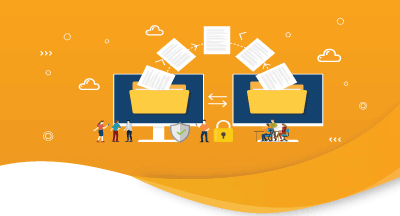Course Design By
Nasscom & Wipro
Home /Data Science & AI/ Artificial Intelligence Training Institute in Noida
Learn to extract business insights from big data. Join now to learn from an AI expert.
In collaboration with

40 Hrs.
Duration
Online/Offline
Format
LMS
Life Time Access
we train you to get hired.


First, you will receive sessions regarding its basic information and definition.
Furthermore, you will also receive sessions concerning 'Python for Data Analysis.
Your information concerning Math for Machine Learning will also get enhanced.
Our team will also help you in imbibing information concerning Data Visualization in Python.
Your overall information regarding Data Analysis using SQL, and advanced SQL will get uplifted.
In the initial level, you will earn around Rs 8 to Rs 7.5 Lakh annually.
Later on, you can earn up to Rs. 50 Lakh if you have acquired the latest skills and information.
Post imbibing detailed information regarding AI, you will turn into a pro.
Post having this skill, you will be able to enter into a multi-national company that will also offer you a quite higher salary package.
Imbibing in-depth information concerning this technology will eventually turn you into an expert.
Enrolling in this course will allow you to examine this subject right from the scratch.
By knowing every side of Artificial Intelligence Training in Noida, you will end up acquiring a higher position and in a good workplace.
Your basic and core information will be cleared.
You will have various job opportunities in hand.
You will have to co-ordinate with the professionals such as programmers, coders, Data scientists, etc.
You will also have to design and handle the AI development process and overall infrastructure of a product.
You will also have to execute statistical analysis and interpret results to guide your organization's decision-making process.
You will also have to integrate necessary functions and processes for a data science team.
Working as an AI Engineer will indulge you in making Machine Learning models into APIs that other applications can evolve with.
Your salary structure will positively get increased.
Your information concerning AI will get strengthened.
You will always have numerous jobs offers in hand.
Further, in your career, you will be able to turn into a freelancer and make a good additional income as well.
Marj Technologies, Websites, Masters India, etc. are some of the good set-ups hiring skilled candidates.
In fact, our trainers will thoroughly help you passing the interview by often conducting a mock test.
The main aim of this course is to assist you to get settled in a well-established organization.
Associating with us will give you enough chances to obtain the latest information concerning the Artificial Intelligence course.
Here, you will obtain information regarding its related course.
Croma Campus will offer you placement assistance.
Well, right from the beginning, our faculty members will give you suggestive tips to clear the interview process.
we train you to get hired.

By registering here, I agree to Croma Campus Terms & Conditions and Privacy Policy
Foundation for AI: Learn traditional ML models, evaluation, and workflows.
Understand the inner workings of neural networks and train them with Keras.
Master CNNs, object detection, segmentation, and deployment.
Train text models from scratch and with BERT.
Take models from notebooks to real-world applications.
Build, evaluate, and deploy a mini AI project end-to-end.
Fake News Detection (NLP)
Plant Disease Detection (CV)
Job Match/Resume Screening (Tabular + NLP)
Visual Product Search Engine (CV)
Chatbot for Customer Support (NLP)
Energy Consumption Forecasting (Time Series + Tabular Data)
+ More Lessons
Course Design By
Nasscom & Wipro
Course Offered By
Croma Campus
Stories
success
inspiration
career upgrade
career upgrade
career upgrade
career upgrade
You will get certificate after
completion of program
You will get certificate after
completion of program
You will get certificate after
completion of program
in Collaboration with

Empowering Learning Through Real Experiences and Innovation
we train you to get hired.
Phone (For Voice Call):
+91-971 152 6942WhatsApp (For Call & Chat):
+919711526942Get a peek through the entire curriculum designed that ensures Placement Guidance
Course Design By
Course Offered By
Ready to streamline Your Process? Submit Your batch request today!

1. In recent times Python learning is hugely in demand. And I was looking for an institution to get myself enrolled in this course to become a Data Scientist. They have the best trainers and an affordable fee structure. It's been months now and I am fully satisfied with the trainers, live sessions, Read more...

Enrolling yourself in the Deep learning certification program of Croma Campus is the best way to master all the concepts of data science and deep learning. My experience with these people has been very amazing and positive. The support/guidance I got from the trainer is highly commendable Thanks, te Read more...

Hello, I have joined Croma Campus for a few months in the course helped in acquiring good knowledge. Also, there are many extra classes held by the trainer. There are many mock sessions given after the post completing the course. The salary offered in the industry is high to the candidates. Read more...

I am Pooja Yadav from Haryana. I have joined Croma Campus for learning this course. The trainer helped me to learn advanced practical knowledge and new innovative skills to enhance my ability. Also, the faculty is available in the odd hours for helping. There are many extra reference study materials Read more...

Hi, my name is Sanjeev Kumar. I have recently completed my Django Framework Certification Training from Croma Campus which is the brand name in the domain of technical education. It provides me with well-updated study material which is concerned with the latest industry trends. After the training co Read more...

Croma Campus has well-experienced faculties who are working as a top professional in the industry. I have recently completed my Artificial Intelligence Certification training from this institute and it gives me remarkable experience. With world-class infrastructural facilities, it has a student-frie Read more...

Hi, my name is Vishal Jha currently I am associated with L&T. I got this amazing opportunity with the help of our specialized trainers. Due to the continuous practice through the mock interview, I get to clear out the Interview of this MNC. Apart from the training provided the behavior of trainers a Read more...

Hi, my name is Ankit. I currently work as a Data Science at HCL. My interview in this company was scheduled by Croma Campus as I have done 2 months of Masters in Data Science course from it. I managed to crack this interview and the whole credit of my success goes to my Data Science trainer who dedi Read more...

I have joined Croma Campus for taking the Masters in Data Science. It is a good place to learn. Helps in gaining the skills & knowledge. Read more...
Croma Campus provides amazing Artificial Intelligence Training in Noida as per the current industry standards. Our training tactic will enable professionals to secure placements in MNCs. Croma Campus is one of the most recommended Artificial Intelligence Training Institute in Noida that offers hands-on practical information / practical implementation on live projects and will ensure the job with the help of advance level Artificial Intelligence training courses.
Artificial Intelligence (AI) assistance for a job - Like Data Scientists, Software Analysts and Developers, Computer Engineers and Computer Scientists, Algorithm Specialists, Research Scientists and Engineering consultants, Maintenance Technicians, and Mechanical Engineers.
Croma Campus: Artificial Intelligence Training Institute in Noida is conducted by specialist working certified corporate professionals having 8+ years of experience in implementing real-time Artificial Intelligence projects. Candidates will implement the following concepts under Artificial Intelligence: Fundamentals of Reinforcement Learning, Q-Learning Intuition, Building a Self-Driving Car, Creating the environment, Building an AI on real-time projects along with Artificial Intelligence Placement Training modules like aptitude test preparation, etc.
There are four types of Artificial Intelligence: Reactive Machines, Limited Memory, Theory of Mind and Self-Awareness.
The ways to connect Croma Campus.

Highest Salary Offered
Average Salary Hike
Placed in MNC’s
Year’s in Training

fast-tracked into managerial careers.
Get inspired by their progress in the
Career Growth Report.
FOR QUERIES, FEEDBACK OR ASSISTANCE
Best of support with us





An OTP on your submit Mobile No has been shared.please check and submit OTP

We’re the best training provider with rigorous industry-relevant programs designed and delivered in collaboration with world-class faculty, industry & Infrastructure.
Share some of your details and we will be in touch with you for demo details, and know about Batches Available with us!
By registering here, I agree to Croma Campus Terms & Conditions and Privacy Policy



Enter your email and phone number
For Voice Call
+91-971 152 6942For Whatsapp Call & Chat
+91-9711526942Talk to Career Counsellor

Stay ahead in your career with real-time salary updates.
By registering here, I agree to Croma Campus Terms & Conditions and Privacy Policy

We’re the experts in web design and development for the start up next door and the fortune 500.

What Benefit You will get from this Program
By registering here, I agree to Croma Campus1 Terms & Conditions and Privacy Policy
Share some of your details and we will be in touch with you for demo details, and know about Batches Available with us!


